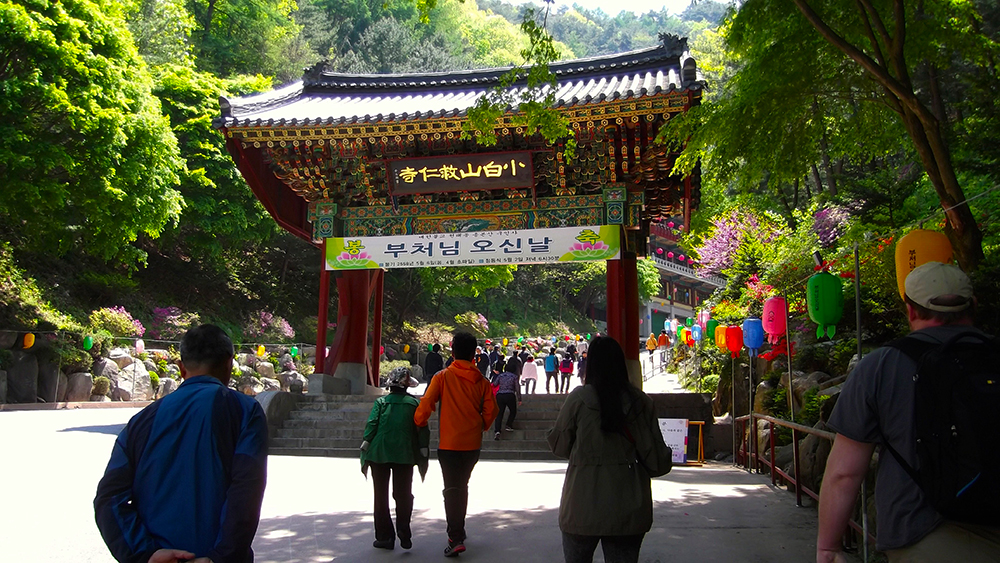Guinsa

The bus drops us at a three story pagoda. A clutch of toothless grannies sit in a long row watching the steady flow of tourists. They're grinning, comparing notes. The parking lot is crowded. Hundreds of people are making the trek to Guinsa Temple Complex. It's a good day for it, spring, with just a hint of chill and a crystal blue sky.
We join the crush heading for the top. The people around us are almost entirely Korean. I glance back once, see trees swallowing the entry pagoda in an ocean of green.
The trail winds between temples, dormitories, and high, arching bridges, so each new turn unfolds a spectacular vista. It's hard not to crane, to just sit and stare. More than fifty buildings, each intricately adorned, are tucked into the long valley running up the Sobaek Mountains. There's enough space to house 10,000 monks.
We hike for an hour between towering temples, across delicate spans of wooden bridges, along twisting walkways and sudden upthrusts of stone. Halfway to the top, the crowd thickens in an open square. The air carries the sharp tang of Korean spices and fermented vegetables. Massive clay pots store an army's worth of kimchi and gochujang.
One of the monks, a beatific woman in grey, finds us looking lost. She makes a gesture offering a meal. We nod and she becomes our guide. We move with breathless ease through the dense crowd, as if we're all alone on these soaring balconies. She pauses, extends a hand to brush the cheek of a squalling child. The girl quiets, stares with wide, startled eyes.
The monk leaves us with a smile and a bow outside a cafeteria. The sign by the door says lunch is free for all visitors, 11:30 to 1:30. The food is simple, entirely vegetarian, and delicious, served in a deep grey platter. A woman near the door politely asks to make sure we eat everything.
We clean our plates and return to the world. The balcony is packed with visitors and quiet conversation. Many enjoy a post-meal coffee from the vending machines or a drink of water from the rain-fed stone bowls.
We came with water bottles, so we buy ourselves a couple cups of coffee at ₩300 each. Then we wander off to find a quiet place to digest.
Rested, we push higher. A dark, narrow stairway leads up, past the cafeteria, past the endless pots of food. We climb, break out into sunshine at the base of an Olympian temple. This is the entrance to the Dharma Law Hall, the largest of its kind in Korea.
The interior is soft and dim, with that rich, heady smell of ancient wood that marks places of worship. A stone staircase curls the exterior, leading even higher. I look up and try to decide if my knees are in a forgiving mood.
Today is the day before Buddha's birthday, and monks and volunteers are getting ready for the festival. Every surface is strung with a kaleidoscope of hanging lanterns.
We make the last climb to the upper complex and find the golden temple to the great teacher Sangwol Wongak, who guided Guinsa's construction after World War II. The stone courtyard in front is set for an epic celebration. Statues to the Chinese Zodiac stand next to traditional figures of Buddhist mythology. Paper lanterns dangle streamers above our heads. With all the vivid color, it's like walking through fireworks.
Even without the decorations, the view is breathtaking. The whole valley stretches below, distant mountains fading to a blue haze.
There is another trail, rough stairs winding even further up the mountain. Sangwol Wongak's grave is described as a 20 minute hike from the upper complex. But the truly ambitious can just keep going, all the way to the peak of Mt. Shinseonbong and the Sobaeksan National Park, 1389 meters up.
We have more humble legs today. We make our winding way back to the base. The grannies haven't moved in the hours we've been gone. We buy a pair of bus tickets and sit beside them, watching the world swing on, basking in the joy of being off our feet, of being in the quiet, and in the endless river of Korea streaming past outside.
-Sam
Getting to Guinsa:
The temple complex is remote, so it isn't the easiest place to visit if you don't have a car. Some cities, such as Chungju, Busan, Danyang, or Seoul (from the East Terminal) will let you buy a direct ticket from the bus depot. You can also hop the 260 bus in downtown Jecheon (takes about an hour). If your city doesn't offer a direct route, then the best way to get there is to get a ticket to Danyang and catch a second bus on to the temple (the bus from Danyang to Guinsa is about 30 minutes and runs fairly regularly throughout the day).
Guinsa also offers templestay. It costs around ₩40,000 per person, but they have English Language instruction for anyone interested in some immersion in Korean Buddhist practices, and an opportunity to walk the mountain complex in the wee hours of the morning.





















